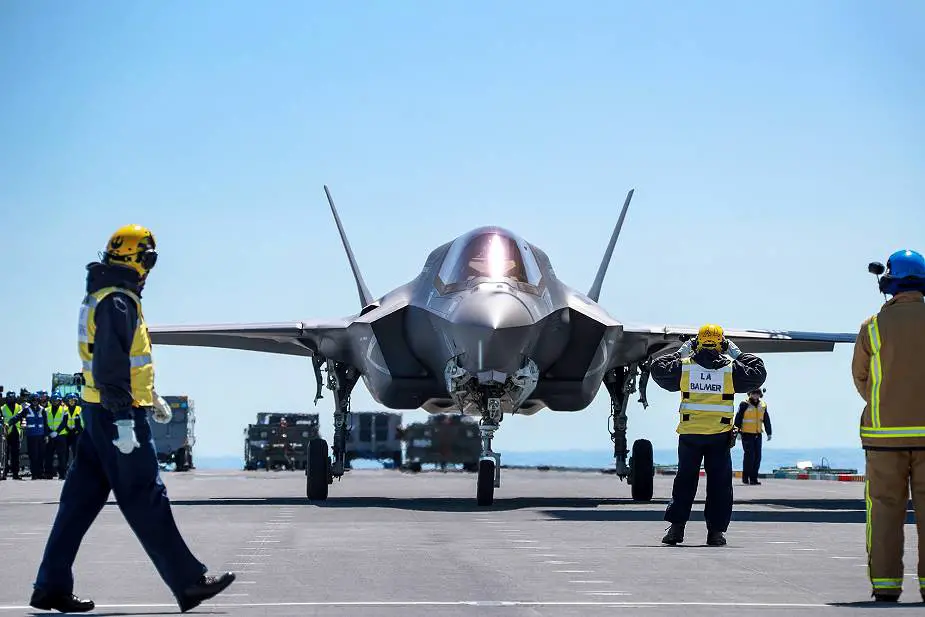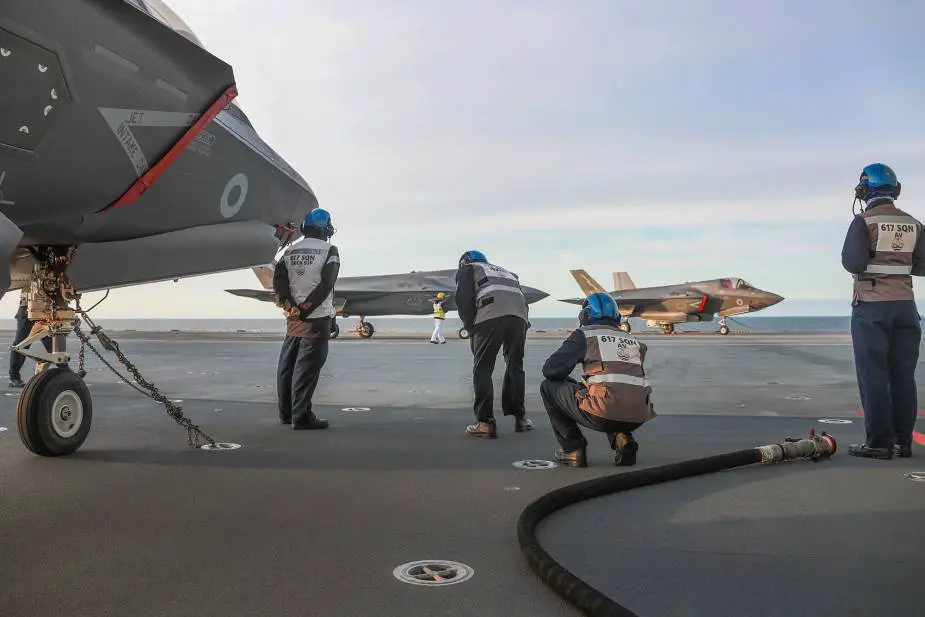British Navy continues to complete operational sea training with F-35B, the short takeoff/vertical landing (STOVL) version of the American-made F-35 stealth fighter aircraft from the aircraft carrier HMS Queen Elizabeth. According to Tweet released by the HMS Queen Elizabeth, on June 19, 2020, delegated assessors of Commander Fleet Operational Sea Training have declared, "We are trained and safe to conduct Carrier Strike operations".
Follow Navy Recognition on Google News at this link
 F-35B short takeoff/vertical landing STOVL onboard British Navy HMS Queen Elizabeth aircraft carrier. (Picture source Twitter account NavyLookout)
F-35B short takeoff/vertical landing STOVL onboard British Navy HMS Queen Elizabeth aircraft carrier. (Picture source Twitter account NavyLookout)
In September 2018, the British Navy has announced that the first British F-35B Lightnings landed for the first time on the new British Navy aircraft carrier HMS Queen Elizabeth. British Navy Commander Nathan Gray and RAF Squadron Leader Andy Edgell were the first pilots to make history by landing their F-35 Lightning stealth jets on the flight deck of Britain's newest carrier.
HMS Queen Elizabeth is on track to deploy on global operations from 2021. Meanwhile, the UK has now taken delivery of 16 out of a planned 138 F-35 jets as part of its world-leading fleet of military aircraft for use by the Royal Navy and Royal Air Force.
Currently, the British Navy has two Queen Elizabeth class aircraft carriers. The lead ship, HMS Queen Elizabeth commissioned on 7 December 2017 and is scheduled to be fully operational in 2020. The second, HMS Prince of Wales, was launched on 21 December 2017 and was commissioned on 10 December 2019.
The two aircraft carriers of the British Navy use a ski-jump, an upward-curved ramp that allows aircraft to take off from a runway that is shorter than the aircraft's required takeoff roll. By forcing the aircraft upwards, lift-off can be achieved at a lower airspeed than that required for sustained flight, while allowing the aircraft to accelerate to such speed in the air rather than on the runway. Ski-jumps are commonly used to launch airplanes from aircraft carriers that lack catapults.

The HMS Queen Elizabeth can carry a total of 40 F-35B fighter aircraft. The Carrier Air Wing squadron is able to launch 24 aircraft in 15 minutes and the maximum recovery rate is 24 aircraft in 24 minutes. The Air Wing is also composed of nine anti-submarine Merlin HM2 and four or five Merlin for airborne early warning. To conduct land operations, the aircraft carrier can also carry a mix of helicopters including CH-47 Chinook, AH-64 Apache, Merlin HC4, and Wildcat HM2.
In December 2006, the British Ministry of Defense has announced that it would acquire 138 F-35s for the Royal Air Force and the Royal Navy. In November 2015, Chancellor George Osborne announced that the UK will order the full original total of 138 F-35 aircraft to equip the Royal Navy's two new Queen Elizabeth-class aircraft carriers.
The F-35 family includes three variants — all single-seat jets. The F-35A conventional takeoff and landing variant, the F-35B short takeoff/vertical landing variant, and the F-35C carrier variant.
The F-35B can land vertically like a helicopter and take-off in very short distances. This allows it to operate from austere, short-field bases and a range of air-capable ships. The F-35B is operated by the United States Marine Corps, the United Kingdom, and the Italian Air Force. The F-35B is in service with the 17 and 617 Squadrons of the British Air Force.
The F-35B can be armed with different types of weapons including one 25mm cannon, air missiles, and two bombs up to 450 kg. There are also two wingtip mounds for air-to-air missiles and four for air to surface or ground missiles.



